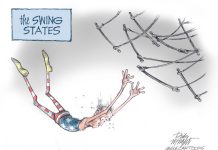Our state cheerleaders, quite naturally, are proclaiming Indiana is hot. They mean we’re attractive to firms wanting to locate facilities for future production. We cannot verify their statements. All we can do is look at the evidence at hand.
Nationally, we hear California is dead-in-the-water with citizens and businesses fleeing for Texas and Idaho. Likewise, if Illinois is a rotting ship, are those rats moving to Indiana?
There are so many ways of examining evidence look for “the truth.” Let’s try GDP, or gross domestic product, our imperfect measure of economic activity.
How have the states fared, jumping the gap between 2019 and 2021?
Nationally, GDP, adjusted for inflation, grew by 3% between 2019 and 2021. This was the result of a decline of 2.8% in 2020, but a growth of 5.9% in 2021.
What? Real GDP fell by just 2.8% in 2020? Yeah. While we cut back on spending for services — down 6.6% in 2020 — we needed bigger TVs, faster computers and more stuff — spending on durable goods up 10%. Our efforts to fight the bad contributed to more economic activity.
That’s what it is about GDP. It measures what we do. It does not judge whether we are enjoying what we do. We buy cigarettes this year and medical services later. We buy fine art and porn.
California alone contributed 25% of the nation’s growth in real GDP between 2019 and 2021. Indiana accounted for only 1.5% of the nation’s growth in real GDP.
California had a growth rate of 5.3%, nearly double the nation’s 3% and more than double Indiana’s 2.5% increase, which is 27th in the nation, comfortably mediocre.
Our Hoosier leaders, however, would have us check the most recent data. OK. Real GDP for the U.S., from mid-2021 to mid-2022, advanced by 1.8% and heavy-breathing Indiana grew by 1.7%.
Across the nation, social commentators are declaring the COVID pandemic transformed our lives. To-your-door delivery is the death of retail trade as we knew it. Work from home is forever embedded in our work environment. The malls and office buildings will all be converted to housing. The resulting higher density will bring back public transit.
But that’s not all. Less commuting and the agglomeration of economic functions (whatever that means) will be complemented by tiny electric cars which end congestion and make parking painless.
More likely, it will be many years before we understand what happened in 2020 and thereafter. Which changes are permanent and which transitory? Among the many damaged relationships, personal and commercial, which possess resiliency, and which will perish?
To this point, the Indiana recovery has been dominated by motor vehicles, bodies and trailers, and parts manufacturing. And 29 of our 65 sub-sectors have yet to achieve their pre-COVID output levels. Is this the shape of our brave new world?
Morton Marcus is an economist. Reach him at [email protected]. Follow his views and those of John Guy on “Who Gets What?” wherever podcasts are available or at mortonjohn.libsyn.com. Send comments to [email protected].





